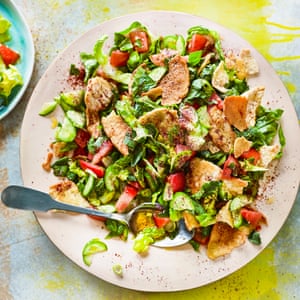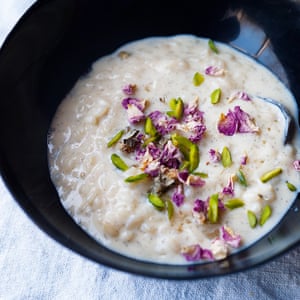20 best Mediterranean recipes: part 1 | Life and style
Sarit Packer and Itamar Srulovich’s pomegranate molasses chicken with bulgar salad
This is a good one to make when people come round, as it is really hard not to like â€" sweet and sour, plenty of textures, pretty colours and virtually everybody likes chicken. Using chicken thighs here makes it almost impossible to dry the meat out and ensures plenty of chicken flavour to come through the strong marinade.
Dinner for 4
vegetable oil 1 tbsp, for frying
chicken thigh fillets 8, skin removed
For the marinade
garlic 2 cloves, peeled and sliced
green chilli ½-1 (depending how hot you like it), sliced
pomegranate molasses 3 tbsp
vegetable oil 1 tbsp
freshly ground black pepper ½ tsp
For the salad
bulgar wheat 200g
salt ½ tsp
olive oil 1 tsp
boiling water 200ml
shelled pistachios 50g, roasted and coarsely chopped, half reserved to sprinkle on top
currants 75g
dried mint 2 tsp
pomegranate molasses 1 tbsp
fresh pomegranate seeds 50g, 1 tbsp reserved to sprinkle over the top
mint 1 small bunch (about 15-20g), roughly chopped
parsley 1 small bunch (about 15-20g), roughly chopped
Mix the marinade ingredients together and use to coat the chicken all over.
Cover and keep in the fridge for a minimum of 2 hours to marinate. You can start the meat marinating up to 48 hours in advance â€" just leave it in the fridge until you are ready to start cooking.
Preheat the oven to 200C/gas mark 6.
Place the bulgar wheat in a bowl with the salt and oil, pour over the boiling water and cover with cling film for 5 minutes. Uncover and fluff up the bulgar using a fork.
Add all the remaining salad ingredients except those you have reserved to use as garnish, and stir well.
Heat the vegetable oil in a large frying pan over a medium heat and place the chicken thighs smooth-side down in it. Season with salt and pepper and fry for 2-3 minutes until the thighs go a lovely dark golden colour, then flip them over and cook for a further 2 minutes. Place the frying pan in the oven for 12 minutes, by which time the chicken should be cooked through.
Spoon the salad onto individual plates or a large serving platter and top with the chicken and the juices that have accumulated in the frying pan. Sprinkle with the reserved pistachios and pomegranate seeds to garnish.
From Honey & Co â€" Food from the Middle East by Sarit Packer and Itamar Srulovich (Hodder & Stoughton, £25)
Anissa Helou’s fattoush â€" mixed herb and toasted bread salad

Serves 4
gem lettuces 4, or 1 large cos lettuce (about 400g)
spring onions 1 bunch (100g), trimmed and thinly sliced
mini cucumbers 3 (300g), sliced in medium-thin half circles
red tomatoes 3 firm (300g), chopped into bite-sized pieces
flat-leaf parsley 1 bunch (200g on the stalk), washed, dried, most of the stalks cut off, coarsely chopped
mint ½ bunch (100g on the stalk), leaves only, coarsely chopped
purslane ½ bunch (100g on the stalk), leaves only
For the dressing
sumac 3 tbsp
salt to taste
extra virgin olive oil 6 tbsp
For the bread garnish
pita bread 1 medium, opened up, toasted and broken into bite-sized pieces
Strip and discard any outer damaged leaves of the lettuce, wash and dry the rest, then cut across in 1cm strips. Put the shredded lettuce in a salad bowl and add the rest of the salad ingredients. Sprinkle with sumac and salt to taste, pour in the olive oil and toss lightly together. Taste, adjust seasoning if necessary, and mix in the toasted bread. Serve immediately before the bread goes soggy.
From Lebanese Cuisine by Anissa Helou (Grub Street, £12.99)
Marcella Hazan’s white clam sauce

Everywhere in Venice â€" or in Italy for that matter â€" one can eat spaghetti with clams, but none tastes like the dish that Cesare Benelli makes at Al Covo, the restaurant he owns with his Texan wife, Diane. Cesare’s genial variation on this timeless theme consists of holding back the natural juices of the just-opened clams, draining the pasta while it is still underdone and finishing cooking it in a frying pan together with the clam juice. The pasta, by the time it becomes fully cooked, drinks up all the fresh clam juices, achieving a density and richness of flavour no other version of the dish can match.
Serves 4
clams 18, live, in their shells
extra virgin olive oil 5 tbsp
garlic 2 large cloves, peeled and sliced paper thin
parsley 1½ tbsp, chopped
hot red chilli pepper 2 tsp (or to taste), chopped
plum tomato 1, fresh, ripe, firm, cut into 1cm dice with its skin on, but drained of juice and all seeds removed
dry white wine 100ml
pasta 450g (see note below)
fresh basil leaves 6, torn into 2 or 3 pieces
Soak the clams for 5 minutes in a basin or sink filled with cold water. Drain and refill the basin with fresh cold water, leaving in the clams. Vigorously scrub the clams one by one with a very stiff brush. Drain, refill the basin and repeat the whole scrubbing operation. Do this 2 or 3 more times, always in fresh changes of water, until you see no more sand settling to the bottom of the basin. Discard those that stay open when handled. Put them in a pan broad enough so that the clams don’t need to be piled up more than 3 deep, cover the pan, and turn the heat to high. Check the clams frequently, turning them over and removing them from the pan as they open their shells.
When all the clams have opened up and you have taken them out of the pan using a slotted spoon, detach the clam meat from the shells and gently swish each piece in the pan juices to rinse off any sand. Try not to stir up the juices in the pan any more than you must. Unless the clams are exceptionally small, cut them into 2 or even 3 pieces. Put them in a small bowl pour 2 tablespoons olive oil over them, cover the bowl tightly with cling film, and set it aside for later, but do not refrigerate.
Line a strainer with kitchen paper and filter the clam juices in the pan through the paper into another bowl. Set aside for later.
Choose a frying or saute pan broad enough to contain the pasta later. Put in 3 tablespoons of olive oil and the sliced garlic, and turn the heat to medium-high. Cook the garlic, stirring it, for just a few seconds without letting it become coloured, then add the parsley and the chilli pepper. Stir once or twice, and add the diced tomato. Cook the tomato for 1-2 minutes, stirring it from time to time, then add the wine. Simmer the wine for about 20-30 seconds, letting it reduce, then turn the heat off.
Cook the pasta in abundant salted boiling water until it is very firm to the bite, barely short of being fully cooked. When you bite a piece off, it should feel slightly stiff and the narrowest of chalk-white cores should be showing in the centre of the strand.
Turn the heat on to high under the frying or saute pan, drain the pasta and transfer it immediately to the pan. Add all the filtered clam juice and cook, tossing and turning the pasta, until all the juice has evaporated.
If the pasta was not too underdone when you drained it, it should now be perfectly cooked. Taste it and, in the unlikely event it needs more cooking after the clam juices have evaporated and been absorbed, add a small amount of water.
As soon as the pasta is done, before you turn the heat off, add the cut up clams with all the oil in the bowl and the torn basil leaves, toss in the pan 2 or 3 times, then transfer to a warm platter and serve at once.
Note on pasta
Spaghettini takes to clam sauces more successfully than other shapes. A close enough second is spaghetti. If you should want to use fresh homemade fettuccine instead of spaghettini, bear in mind that it will cook much faster than boxed, dry, factory-made pasta. Before cooking it, put the clam juice in the frying pan and boil away half of it, so that when you add the fettuccine to the pan it will take less time to cook down all the juice.
From The Essentials of Classic Italian Cooking by Marcella Hazan (Boxtree, £30)
Marianna Leivaditaki’s Cretan pies with slow-cooked lamb, aubergine and sheep’s cheese bechamel

This is a recipe that most will recognise as the ingredients are very similar to that of moussaka; a dish eaten and loved by many. Slow-cooked lamb scented with warm spices, sweet fried aubergines and creamy bechamel make these pies an irresistible snack.
For me, making the filo pastry in exactly the way I was taught as a child is something I love. Because of the amount of olive oil in the dough, when fried these pies puff up and are full of air pockets and crunchiness. You bite into them and the rich, aromatic filling is just so delicious and moreish they simply make you smile.
The pies are usually eaten like a snack in the same way that you would eat a pasty. However, they also go very well with a chopped tomato and fresh mint salad simply seasoned with olive oil and sea salt.
Makes approx 15 pies
For the lamb
olive oil 50ml
lamb shoulder 500g, off the bone, cut into bite-size chunks
red onion 300g, finely diced
fresh tomatoes 500g, roughly chopped
red wine 200ml
cinnamon stick 1
ground cloves ½ tsp
ground black pepper ½ tsp
salt to taste
For the pastry
plain flour 500g
olive oil 250ml
vinegar 1 tsp
salt 1 tsp
warm water around 250ml
For the aubergines
aubergines 600g, cut into thick slices and salted
vegetable or olive oil for deep frying (use the same oil to fry the aubergines and then the pies)
For the bechamel
butter 70g
plain flour 1 tbsp
milk 300ml
hard sheep’s cheese 150g, grated
Heat a saucepan over medium heat, add the olive oil and the lamb and brown on both sides. Add the onions, tomatoes, wine, spices and salt, and mix. Adjust the seasoning if necessary. Cover the ingredients with a sheet of parchment paper and a lid and cook for about 30 minutes or until the meat is tender and the sauce is thick.
For the pastry, place the flour in a bowl and add the olive oil, vinegar and salt. Start adding warm water slowly while kneading the dough. You usually need a similar amount to that of the olive oil. Stop adding water when your dough is soft and silky. Don’t over-knead the dough; stop as soon as you have a dough that is workable. Place in a bowl and let it rest for 15-20 minutes.
Make the bechamel by caramelising the butter in a small pan until it is golden. Add the flour and whisk vigorously for a minute. Add the milk and cheese and cook gently until the sauce thickens.
Deep fry the aubergines in a pan until golden brown.
To make the pies, split the dough into two. Roll out the pastry as thinly as you can without breaking it. Cut out round discs using a plate (approx 16cm in diameter).
Mix together the lamb, aubergines and bechamel in a bowl.
Place about one tablespoon of the filling onto one half of the pastry and fold the other half over to seal the pie and create a half-moon shape. Seal the pies using the end of a fork to pinch both sides together.
Fry the pies in olive or vegetable oil until golden brown on both sides.
Serve immediately.
Marianna Leivaditaki is head chef of Morito Hackney Road, London E2
Yotam Ottolenghi and Sami Tamimi’s cardamom rice pudding with pistachios and rose water

Rachela Shrefler, now in her seventies, came to Jerusalem from Iran as a child and later met her husband, Ezra Shrefler, a Turkish-Kurdish Jew. They are both cooks and own Azura, a restaurant in Machne Yehuda market. Among the many pots Rachela has on the stove on a Friday for the Saturday “raid†â€" when dozens of hungry family members descend on their house â€" is a pot with rice pudding. The rice sits on the hot platter until Saturday morning, when the family members sit together and eat it. It is simple and delicious, containing only rice, milk and sugar, with a dusting of ground cinnamon.
Rice pudding was the most common everyday dessert throughout the old Sephardi world, with variations according to community, and was eaten hot or cold, at various times of the day. Possible additions would be honey, saffron, mastic, cinnamon and other sweet spices.
Rice pudding is also common in Arab homes. Sami’s mother used to prepare it on occasion, causing the kids to go into clashes over the caramelised bits that formed at the bottom of the pot. They would have it with sugar syrup flavoured with flower blossom.
Serves 4
full-fat milk 400ml
double cream 120ml
vanilla pod 1, seeds scraped
cardamom pods 8, lightly crushed
pudding rice 120g
unsalted butter 30g, diced
condensed milk 2 tbsp
acacia honey 1 tbsp, or another mild-flavoured honey
salt
unsalted pistachios 3 tbsp, roasted and slivered or lightly crushed, to garnish
dried edible rose petals 1 tbsp, to garnish
For the syrup
acacia honey 1 tbsp or another mild-flavoured honey
rose water ½ tbsp
Put the milk, cream, vanilla (pod and seeds) and cardamom in a medium saucepan and place on a high heat. As soon as the mix is about to reach boiling point, remove from the heat, allow to cool down and leave in the fridge to infuse overnight, or at least a couple of hours.
To prepare the syrup, stir the honey, rose water and 1 teaspoon of water well until the honey dissolves and set aside.
Add the rice to the pan with the infused milk and cream, bring to the boil and simmer on a medium heat, stirring all the time, for 20 minutes. The rice should cook through but still retain a bite and the pudding should be thick. You will need to add a little bit of water, up to 50ml, towards the end of the cooking if the pudding becomes too thick before the rice is done.
Remove the pan from the heat and carefully pick out the cardamom pods and vanilla pod. Stir in the butter, condensed milk, honey and a pinch of salt. You can chill the mix now (and re-heat in a microwave oven later) or serve immediately in little flat bowls, sprinkled with pistachios and rose petals and drizzled with the syrup.
From Jerusalem by Yotam Ottolenghi and Sami Tamimi (Ebury Press, £27)

0 Response to "20 best Mediterranean recipes: part 1 | Life and style"
Posting Komentar